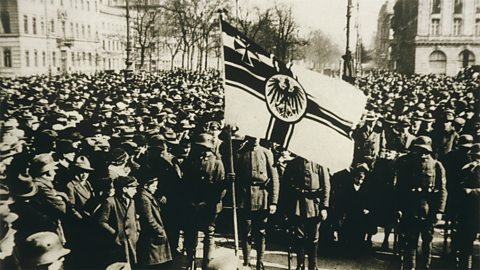Political instability
After Germany lost World War One, the Kaiser fled and a new democratic government of Germany was declared in February 1919 at the small town of Weimar. The Weimar Republic was a genuine attempt to create a perfect democraticA system of government that allows people to have a vote. country.
The political spectrum
Left wing people want more control for the workers and to share the wealth of the country more evenly. The communistA person or country which follows the left-wing ideas of Karl Marx about the redistribution of wealth. (KPD) were on the extreme left wing.
Right wing people want more control for the traditional elite, rich, army etc. The Nazis (NSDAP) were on the extreme right wing.
The extremists on both sides were against the Weimar Republic.

The Weimar Republic faced violent uprisings from various groups, not to mention devastating economic problems. There was continuous violence and unrest.
- Some people in Germany were communists, who wanted to bring in a Russian-style communist government. There were a number of communist uprisings. For instance, in January 1919, 50,000 SpartacistsThe name given to the communist party in post-World War One Germany. rebelled in Berlin, led by the communists Rosa Luxemburg and Karl Leibknecht. The rebellion was put down by the army and the right-wing Freikorps in bitter street fighting. Both sides suffered significant losses.
- In March 1920, there was a rebellion - the Kapp Putsch. The right-wing nationalist Dr Wolfgang Kapp took over Berlin aiming to set up a new government as the rebels were angry at them for signing the Treaty of Versailles. The army refused to attack him and he was only defeated when the workers of Berlin went on strike organised by left-wing activists.
- In 1920, after the failure of the Kapp Putsch, a Communist paramilitary group called the Red Army rebelled in the Ruhr.
- Nationalist terrorists assassinated 356 government politicians, including Walter Rathenau, the foreign minister, and Matthias Erzberger who had been finance minister. The judges, many of whom preferred the Kaiser's government, consistently gave these terrorists light sentences, or let them go free.
The Weimar government's main crisis occurred in 1923, when the Germans failed to make a reparationMonetary compensation from an individual, group or state to compensate victims. payment on time, which set off a train of events.
- The French invaded the Ruhr to take goods by force.
- The Weimar Government ordered workers to follow "passive resistance" whereby they stopped working and did not produce anything that the French could take.
- The workers obeyed and the Ruhr area stopped producing goods, however the workers still needed wages.
- The government printed more money for the workers but this soon became worthless with inflation.
Hyperinflation
A sudden flood of paper money entered the economy and a general strike meant that no goods were being manufactured. These factors meant there was more money chasing fewer goods. This, combined with a weak economy ruined by the war, all resulted in hyperinflation.
Prices ran out of control, eg a loaf of bread cost 250 marks in January 1923 rose to 200,000 million marks in November 1923. German's currency became worthless. Middle-class people with savings were particularly badly hit.